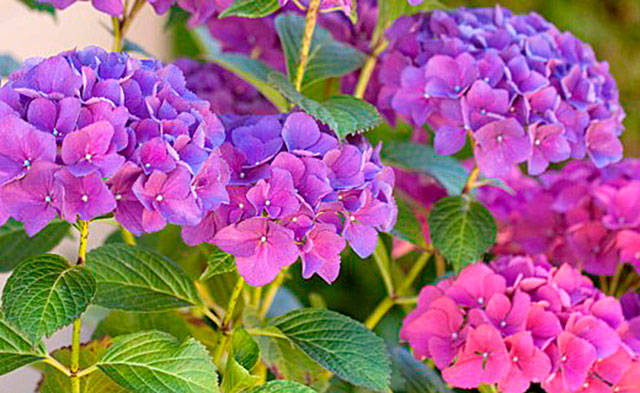With flower clusters like fluffy balls of cotton candy, hydrangeas are among the most popular summer-flowering shrubs for shady gardens. Hydrangeas can provide huge flower heads of white, pink, blue and blends of these colors above their rich green leaves.
The word “hydrangea” comes from two Greek words meaning “water vessel,” which describes the cup-form of the small seed pod.
There are 70-75 species of hydrangeas, the most popular being the Hydrangea macrophylla, which are deciduous shrubs originally native to Japan. They include mop-head hydrangeas, which have huge round heads of sterile flowers, and lace-cap hydrangeas, which have a central cluster of small fertile flowers, surrounded by a ring of attractive sterile flowers.
There are several varieties of both which vary in size from dwarfs to climbers (consult local nurseries for details).
One of my favorite species, the oak leaf hydrangea (Hydrangea quercifolia), is native to the United States. It has large pointed cones of white flowers that age to dusty rose on dark green attractive leaves (see photo). Growing 4 to 8 feet tall and wide, oak leaf hydrangeas are deciduous and have the added attraction of orange to burgundy fall foliage color.
Hydrangeas should be planted in a spot where they receive some shade during the day. Avoid hot, sunny, dry areas or beds that are baked by the afternoon sun. Morning sun is much preferred by these plants, so an eastern exposure is excellent.
As their name implies, hydrangeas are intolerant of dry conditions and need an evenly moist soil. They do best in beds that have been amended with generous amounts of organic matter, which helps retain soil moisture.
Once planted, it is important to keep hydrangeas well-watered. Hydrangeas also benefit from a 2- to 3-inch layer of mulch – such as leaves, pine straw or bark – over their root system to help maintain moist soil conditions.
Interestingly, the colorful parts of the hydrangeas’ flower heads are not flower petals at all; they are modified leaves that surround the petals (called sepals). The actual flowers are tiny, inconspicuous and located in the middle of the sepals.
Prune in the summer right after the colorful flower heads turn green. Cut off the faded flower heads with about 4 to 6 inches of stem. If you are trying to reduce the size of your bush, cut longer stems with the heads. If you need to reduce the size of the bush, you can cut back shoots to the ground.
Most hydrangeas set their flower buds for the next year in late summer, so any pruning after that removes the flower buds and reduces or eliminates flowers the next year.
The flower heads of hydrangeas are rather unique. Depending on the acidity or alkalinity of the soil the plant is growing in, the sepals can be different colors. Furthermore, you can change the color.
If you have pink hydrangeas and you want them to be blue, treat the soil around the bushes with aluminum sulfate, an acid, (follow label instructions, usually 1 tablespoon per gallon of water) in March and again in October each year. Gradually, over time, the flower heads will turn blue.
If your hydrangeas are blue and you want them to be pink, treat the soil around the bushes with lime (which is alkaline) following the same dosage and schedule. It may take a couple of years to be fully effective, but it can work. The intensity of the color is controlled by genetics and depends on the variety you are growing. White hydrangeas do not have pigment in their sepals and are white regardless of the soil pH.
With proper pruning you will have gobs of these globes, and they are easy to dry so you can enjoy the blossoms all winter!
Bill Wrobel is a Clallam County Master Gardener.



